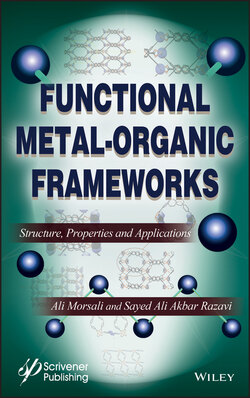Читать книгу Functional Metal-Organic Frameworks - Lida Hashemi, Ali Morsali - Страница 14
1.3 Functional Metal–Organic Frameworks
ОглавлениеWe mentioned that there are three different strategies for functionalization of MOFs. Among these methods, functionalization of organic ligand absorbed massive attention thanks to unlimited diversity in synthesis of organic ligands with different length and shape as well as rich host–guest chemistry of organic functional groups. So, functionalized organic linkers are extensively applied for construction of functional metal-organic frameworks (FMOFs) [14, 48].
The most important reason for introduction of organic functional groups into the framework of MOFs is to control the host–guest chemistry of FMOFs and gain selectivity to special guest molecules in presence of other analytes or tailoring the photoelectrochemical properties of FMOFs. However, moreover than domination in the host–guest chemistry and chemical properties of FMOFs, introduction of organic functional groups influence on the structural properties of FMOFs through induced structural changes and different types of secondary interactions (Figure 1.4).
Although linker functionalization strategy gained lots of attention to control the chemical properties of FMOFs, FMOFs could be developed through other methods. For example a special kind of linker can be stabilized on inorganic nodes or special kind of functional materials like carbonitride, nanoparticles, dyes, graphene or graphene oxide or polyoxometalates can be incorporated into the pores of MOFs to fabricate a multi-functional MOF-based hybrid material (Figure 1.5) [49]. In addition, synergic cooperation of functions in the structure of FMOFs is useful for improvement of practical application of FMOFs.
Figure 1.4 Function–structure and function–application properties of functional MOFs. Function–structure properties include relationship between structural features of MOFs and functional groups while function–application properties encompass the effects of functional groups on different type of applications.
Figure 1.5 Different application of functional or multi-functional MOF-based materials [16].
For a coherent and purposeful study, organic functional groups are sorted in two different methods. Based on first approach, organic functional groups are classified owing to their chemical properties and structural similarities. In this view, applied functional groups into the structure of FMOFs are categorized in four major groups including (I) nitrogenbased functions, (II) oxygen-based functions, (III) sulfur-based functions and carbonyl-based functions. All these four major groups entail a number of organic functional groups (Figure 1.6). In addition to these four major groups of organic functional groups into the pores of FMOFs, there are some of other functions especially phosphonate and fluorine-based functions which are applied in the structure of FMOFs.
In the second approach, organic functional groups are classified based on their role in the structure of FMOFs. In this view functional groups are classified as coordinating sites (Figure 1.7) and gust-interactive sites (Figure 1.8). Functional groups as coordinating site are those which can coordinatively bond to metal ions during the synthesis of MOFs. Coordinating functional groups must be strong coordination bond donor with high chelation ability to develop stable FMOFs. There are two common types of coordinating functional groups. First common coordinating functions are O-donor functions such as sulfonate, phosphonate, enoxide and especially carboxylate. Other common coordinating functions are N-donor functions like pyridine, pyrazine and heterocyclic azole functions including pyrazole, triazole and tetrazole. Although, we mentioned that some functions like carboxylate, sulfonate, phosphonate, enoxide, pyridine, pyrazine and heterocyclic azole functions applied as coordinating sites, this does not mean that these functions did not apply as guest interactive sites. In other word, mentioned functions can apply as both coordinating and guest-interactive sites.
Figure 1.6 Classification of organic functional groups which are applied in synthesis of FMOFs based on their chemical characteristics and structural properties.
Figure 1.7 Common coordinating functional groups in the structure of FMOFs.
Guest-interactive functions are those enabling to interact with guest-molecules for special purpose. In this regard, the guest-interactive functions must remain free during the synthesis of FMOFs or introduced in the framework through post-synthesis modification. Almost all functions applied as guest interactive site to sensitize the FMOFs to special guest.
The next chapters of this book are structured based on these two approaches and effects of any function on the structure and application of FMOFs are discussed in details.
Figure 1.8 Functional groups as guest-interactive sites inside the structure of FMOFs and position of some of common functional groups.
